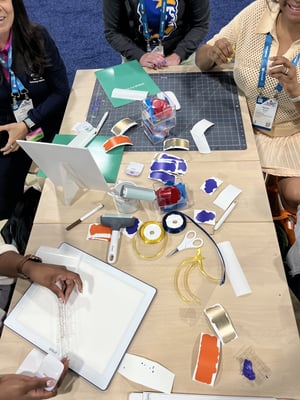Calculating Speed, Distance, and Time




Description of Cricut Lesson & Activity
In this activity, students will calculate speed, distance, and time using the magic triangle method. The teacher will create a large magic triangle with removable sections using a Cricut machine, and students will use finger pointers to uncover the correct formula. As an optional enrichment, students can design their own magic triangles. This hands-on approach makes learning science concepts fun and engaging.
- Mathematics
- Physics
- Science
ISTE Standards
- 1.1 Empowered Learner
1.1a Learning Goals
1.1b Customized Learning Environments - 1.3 Knowledge Construction
1.3.b Evaluate Information - 1.5 Computational Thinking
1.5.d Algorithmic Thinking - 1.6 Creative Communication
1.6.d Customize the Message
State / Local / Other Standards
NGSS Standard: MS-PS2-2 Motion and Stability: Forces and Interactions

For full project details, open in Cricut Design Space.
Click Here
For full project details, open in Cricut Design Space.
Click Here
Click Here
For use in your classroom, download full lesson plan.
Download Here

For full assessment rubric, download here.
Download Here
Learning Objective(s)
- Students will be able to calculate speed, distance, and time using the magic triangle method and apply this knowledge to solve related problems.
Materials Required
- Cricut machine
- Cricut Design Space software
- Cricut mat
- Cricut pen (0.4 Tip, Black)
- Cardstock paper (12" x 12")
- Popsicle sticks, wooden dowel or a pencil
- Glue or tape
- Printed finger cutouts (using Cricut's print-then-cut feature)
- Worksheet with practice problems (attached)
Instructions
Teacher Preparation Using Cricut:
1. Magic Triangle Creation:
- Use the Cricut machine to design and cut out a large magic triangle on a 12 x 12 sheet of paper. The triangle will have three sections: Distance (D), Speed (S), and Time (T).
- Cut out separate pieces for each section (D, S, T) using removable adhesive vinyl or cardstock. These pieces will be used for visualization by placing them on and off the triangle.
2. Finger Pointer Creation:
- Use Cricut's print-then-cut feature to create a cutout of a finger (print on white or colored cardstock paper)
- Print the finger design on cardstock, then cut it out using the Cricut machine.
- Glue the finger cutout onto popsicle sticks to create pointers that students will use to visualize which part of the triangle they are focusing on when solving problems.
Lesson Procedure:
1. Introduction (10 minutes):
- Begin with a brief discussion on the relationship between speed, distance, and time.
- Introduce the magic triangle method as a visual tool to help solve these
problems.
2. Demonstration (15 minutes):
- Show students the Cricut-created magic triangle on the board or using a projector. Explain how each part of the triangle corresponds to the formulas:
■ Speed = Distance / Time
■ Distance = Speed × Time
■ Time = Distance / Speed - Demonstrate how to cover one section of the triangle to reveal the formula needed to solve for that variable.
3. Interactive Activity (20 minutes):
- Hand out the removable pieces of the magic triangle to the students and have them practice placing the pieces on the triangle and using the finger pointers to cover sections as they solve sample problems.
- Allow students to work in pairs, guiding them through the process of using the
magic triangle to solve problems.
4. Guided Practice (15 minutes):
- Distribute the worksheet with five practice problems related to speed, distance, and time.
- Walk around the classroom to provide support as students use their magic
triangles and finger pointers to solve the problems.
5. Review and Conclusion (10 minutes):
- Go over the worksheet problems as a class, discussing the solutions and
clarifying any misconceptions. - Reinforce the importance of the magic triangle as a tool for solving these types of problems.
Assessment
- Students' understanding will be assessed through their ability to correctly solve the worksheet problems and their participation in the interactive activity.
- Using a scoring guide, students will be given points to evaluate their knowledge in the subject.
- This lesson combines the use of technology (Cricut) with hands-on learning to make abstract concepts more tangible and understandable for students.
